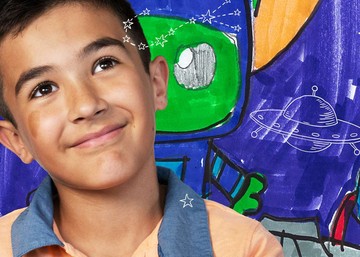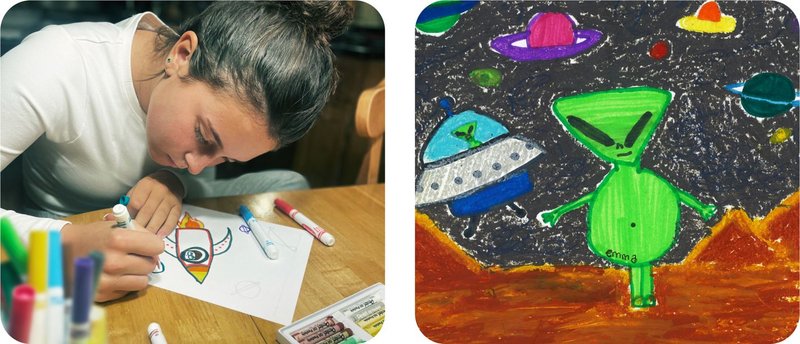

Connecting with your audience through the power of storytelling.
In 1991, the visionary Steven Spielberg released the fantasy adventure “Hook.” This adaptation of the Peter Pan legend follows a grown-up Peter (now Peter Banning) who, long away from Never Neverland, struggles to separate himself from the wheeling and dealing of his career as a high-profile lawyer — often putting his family’s needs on the backburner. That is until his own children are kidnapped by Captain Hook — and Peter must face his past and conquer pirates to save his kids.
Early in his return to Neverland, Peter is unable to fly, unable to fight, and trying to rationalize Tinkerbell as “a complex Freudian hallucination.” But after spending a few days exercising his imagination with the Lost Boys, he gains an unbeatable advantage over his archnemesis — and a lot more respect for the magic around him. The magic of childhood.
No matter what type of product or service you want to share with the world, thinking like a child is often exactly what it takes to create breakthrough ideas that connect with your audience on an emotional level — whether they’re children or not.
It can feel like a big leap to abandon our rational adult brains, but here are some ways to get started — and make marketing ideas that give you a competitive advantage.

Embrace the Outlandish
Young children’s minds are highly flexible and primed for learning. Studies show that, without a lifetime of experience and well-rounded executive reasoning skills, they rely on exploration to come up with ideas and answers — and are not so shy about sharing them with others.
In creative brainstorming, it’s vital to take the same approach. Welcoming all ideas with open arms, regardless of how unconventional or seemingly outlandish they may be. In many cases, "out there" ideas serve as the seeds for groundbreaking innovations.
In marketing, where tactics are constantly evolving and audiences always moving, it's crucial to cast a wide net during brainstorming sessions. If it’s the first thing that comes to mind, it’s probably been done before. A design thinking exercise we like to use is called “Verboten.” In this exercise, we take a look at all the ideas we’ve come up with — or even tactics that feel intuitive — and forbid ourselves from using those. Even if we return to them eventually, it forces us to think more outside the box.
Adults often stifle their own creative potential by self-censoring ideas — or worse, shooting down others’ ideas. Establishing rules for brainstorming may sound counterintuitive but can help you create an environment where everyone feels safe to share their wildest thoughts. I like to use this list of 7 Rules of Brainstorming from IDEO, particularly rule number one: defer judgment.

Don't Overthink It
There’s a difference between thinking broadly (for quantity) and thinking ideas to death. Spending too much time analyzing and critiquing can lead to stagnation. In many cases, our instincts and emotions guide us to more interesting places.
When you have an idea that you like, embrace it and run with it — or go ahead and drop it and find something new. You’re sure to kill an idea if you spend too long dissecting it and poking at its pros and cons.
Driven by the amygdala, children’s minds operate on an emotional level. Things are either fascinating or they’re not. If you’re not inspired or excited by the idea, it probably means that others won’t be very interested in it either. Follow what feels right to break through the “sea of sameness” and explore the uncharted waters of truly unique ideas.

Go Ahead: Play in the Mud
Without a doubt, perfection is the enemy of innovation. You’ll get a lot more done by trying lots of new things rather than trying to make one thing perfect. So how do you try new things?
- Say yes to questionable ideas: Improv comedy wouldn’t be very funny if all the actors stood on stage and waited for better prompts. Work with what you’ve got. Creativity is all about the choices you make with what you’ve got. When your colleague pitches something that seems absolutely absurd, follow them down the rabbit hole for a while — it’s bound to be an adventure.
- Add a twist with “and”: Maybe it turns out your coworker’s idea is interesting — but a little off the mark. That’s okay. As a creative collaborator, you can say "Yes, and." By adding your thoughts and expanding on the initial idea, you can create something that resonates with audiences on a deeper level.
- Make a prototype: If you feel strongly about a creative idea, the best way to sell it to others is making — and testing — a prototype. It shouldn’t be time-consuming or expensive. Even a simple sketch will do. The goal is to quickly share your idea with someone (ideally a member of your target audience) and get their reaction so you can continue to iterate.
The first things you made in childhood probably weren’t your life’s finest creations (that’s why macaroni art usually ends up in a box in the basement), but they were a crucial part of learning — and improving. In the enduring words of Ms. Frizzle from The Magic School Bus, “Take chances, make mistakes, get messy!”

You Need Recess ... and Maybe a Nap
Remember how, as a child, you eagerly anticipated recess and looked forward to those precious moments of unstructured play? Well, the same principle applies to creative ideation. Taking breaks and engaging in physical activity can be a game changer for your creative process.
We know what’s good for the body is generally good for the brain; research has shown that physical activity can boost creativity and cognitive function. Whether it’s by yourself or alongside your team, incorporating short walks, stretching exercises, or even playful games can help refresh your mind and stimulate creative thinking. (If you visit our office, you’re bound to find meeting rooms filled with markers, magazines and fidget toys. This isn’t by accident. We’re serious about playtime.)
Dedicated rest time is equally vital. If you’re really forcing ideas, it might be time to pack it up for the day. Just as a child needs a nap to recharge, so do creative minds. Stepping away from your work, taking a short nap, or practicing mindfulness can help rejuvenate your brain and provide you with fresh perspectives when you return to your ideation sessions.

In Hook, Peter Banning only regains his Pan powers after he lets go of fear, stops rationalizing every choice and opens his imagination to new ideas. By reconnecting with his inner child, he successfully enlists the Lost Boys to help rescue his children.
While the Spielberg film may be a fantastical fiction, its truths stand the test of time: thinking like a child opens us up to greater empathy and more opportunities to connect with those who can help us succeed.
We’d love to help make marketing fun for you again. If you’d like to bounce some ideas off our creative team or want some help thinking outside the box, schedule a play date with us.
Four Tips to Think Like a Child
Embrace the Outlandish
Start brainstorming by pushing the boundaries of your imagination — don’t censor yourself (or anyone else).
Don’t Overthink It
Follow your gut and explore what’s interesting. Use emotion to evaluate your ideas rather than executive reasoning.
Go Ahead, Play in the Mud
Say “yes, and” to ideas that spark your interest, and don’t be afraid to show others rough drafts and prototypes of what you’re envisioning.
Take Time for Recess — or a Nap
Recharge your imagination by taking a break for physical activity — or give your brain some well-deserved rest time (brainstorming is hard for adult brains)!


